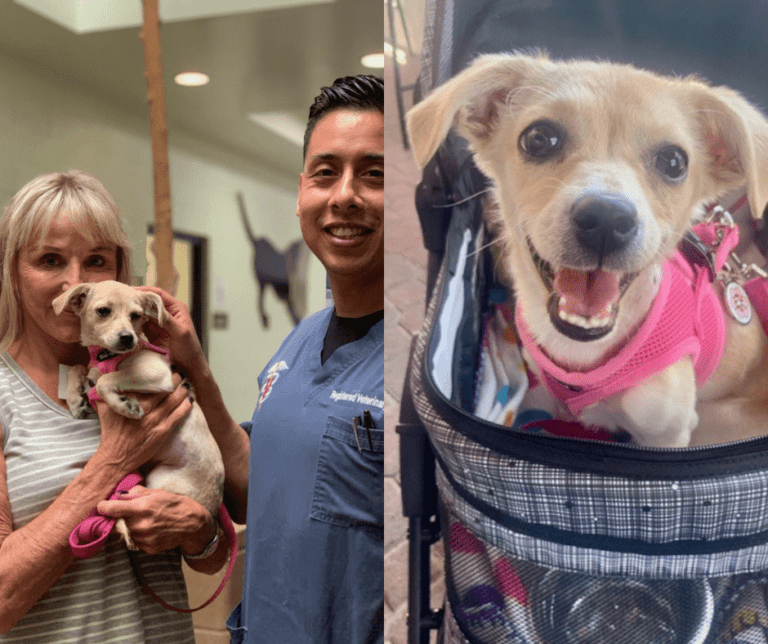Disaster Preparedness for Your Pet

Disasters frequently displace hundreds of pets from their families, and the number one reason they are never found is lack of permanent identification. Disaster preparedness and planning are the best ways to keep your pets safe.
What to Do Before a Disaster
- Provide Your Pets with Proper Identification
The most effective form of pet identification is external ID tags. Disaster can strike at any time, so always ensure that your pet is wearing a collar and updated ID tags. Collars and tags can fall off, however, and the only permanent form of identification is a microchip.
A microchip is a small device about the size of a grain of rice that is implanted beneath your pet’s skin by a veterinarian or local shelter. It contains a unique number used to identify the pet. This number links to your contact information in a microchip registry that allows shelters, veterinarians and humane organizations to alert you if your lost pet is found. Ensure that your pet’s microchip is registered with your contact information.
- Update Microchip Registrations
After your pets are microchipped and registered, it is essential to update your microchip registration every time you move. If your pets are rescued during a disaster, they will be scanned for a microchip, and the rescuer will start an alert that will automatically notify you through the phone numbers and email in your microchip registration. If disaster strikes and your pet is missing, check your pet’s microchip registration to ensure that rescuers are able to contact you.
- Display a Pet Rescue Sticker
Make sure you have a pet rescue window decal which is visible to pet rescue workers.
- Identify Pet-Friendly Emergency Shelters
Not all emergency shelters or hotels allow pets. Before a disaster hits, call your local emergency management office or animal shelter to see if there are places planned for people and pets to stay together in the event of an emergency. Research pet- friendly hotels away from typical disaster zones, or arrange to stay with family or friends outside of your area. Prepare a few options in a range of distances from your home in case of either localized or region-wide emergencies.
- Prepare a Pet Emergency Kit
You can buy a pet emergency kit and add pet-related items to your family’s existing emergency supplies. Your kit should include the following items:
Food and Water. Plan to have at least five days of food, water and portable bowls. Dry food should be in resealable plastic bags. If your pet eats wet food, make sure to buy easy open cans so you don’t need a can opener. Prepare a written feeding schedule as well.
Medication and Medical Records. Keep an extra supply of your pet’s regular medication in a waterproof zip lock bag. Also include a copy of your pet’s vaccination record and microchip number.
Supplies. For cats, include kitty litter and disposable litter boxes. For dogs, pack plastic waste bags and an extra leash and harness. Beds, blankets, toys and clothing are also useful to keep your pet calm and cozy in an emergency situation.
- Store Supplies for a Speedy Exit
Place all of your emergency supplies in a safe, dry, convenient place near your escape route in case you need to leave in a hurry. The safest way to transport a pet in an emergency or disaster is in a carrier or crate, so keep one close to your emergency kit. Frightened pets can be difficult to manage with only a leash and collar.
What to Do During a Disaster
- Don’t Hesitate; Evacuate
Not all disasters come with warning, but if they do, follow emergency response recommendations and evacuate as quickly as possible. Disasters are very stressful on both pets and people, and no one can predict how bad things will get. Do not wait until the last minute to leave. Use your emergency plan as a tool to supplement first responder instructions.
- Leave With Your Pets
If the area is not safe for you, it is not safe for your pets. It may not be possible to return for your pets, so take them with you from the start.
- Check for Found Pet Alerts
If your pets are separated from you, check your cell phone and email constantly. A rescue organization or Good Samaritan may be trying to get in touch with information about your pet and their location. If you cannot access your phone or email, or are unable to retrieve your pets, your emergency contacts and vet will also be notified.
Additional Resources for Disaster Preparedness:
- Preparing your Pets for Emergencies, Federal Emergency Management Agency (FEMA)
- Make a Disaster Plan for Pets, Humane Society United States (HSUS)
- Disaster Preparedness, ASPCA
- Pets and Disaster Checklist, American Red Cross
- Saving the Whole Family Brochure, American Veterinary Medical Association


